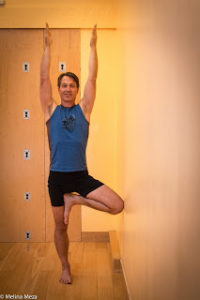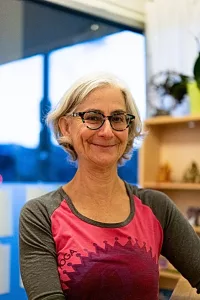
by Nina
After I took yoga teacher and physical therapist Shari Ser’s therapeutic yoga seminar on “Yoga and the Fear of Falling” 11 years ago, I felt that I just had to interview her for this blog! The workshop was so full of in-depth background information about balance and aging, as well as practical yoga solutions for helping students improve and/or maintain good balance. I soon realized that rather than just reporting back to you, it was better for you to get the scoop straight from the expert. Fortunately, Shari agreed to answer a few of my questions. Reading through this interview 11 years later, I think the information here is as relevant as ever so I decided to share it again so readers who missed it the first time around—which I think is most of you—can have a chance to read it now.
Q: Why is the ability to balance so important as we age?
A: The short answer is that if we can’t balance, we fall and break bones or hurt ourselves in different ways. Twenty percent of all Americans have balance issues, and falls are a public health catastrophe. They send people to hospitals and may require costly surgeries and months of pain, suffering, and hard work to try to regain prior levels of functional independence.
In addition, if we are afraid to move because we fear falling, this fear affects every aspect of our lives and starts the spiral of further decline and illness. People who fall are afraid of exercise and movement because of the anticipation of future falls. But if you don’t use your physical body the decline is unrelenting.
Unfortunately decline in ability to balance is part of “normal aging.” Physiological changes inevitably occur in aging; the composition of the muscle fibers changes from fast twitch to slow twitch, which means our reaction times decline. There are changes in peripheral nerve conduction speeds, and we may either overcompensate or under compensate when our balance is challenged. The smooth modulation of our central nervous system is affected as we age. There are intricate feedback systems between our cerebellum, brain stem, cranial nerves, and basal ganglia that need to be working smoothly for us to easily execute our locomotion and peripheral body through space.
Our proprioception (the ability to sense where we are in space) also changes as we age as well as our vestibular system (the balance system that is our inner ear). Some hypothesize that this is due to circulatory changes as we age. There are changes in our auditory and visual systems as we age. We get stiffer in our joints and muscles so we loose the full range of motion these joints may have had previously. Cognitive changes occur in our brain also slowing down the in streaming of information. Balance is a reflexive activity, an unconscious response to a change in stimuli, but to improve balance also requires mental concentration.
Q. How is yoga helpful for maintaining and improving our balance as we age?
A: The maxim “use it or you loose it” is so true with balance! But if we stand in Tadasana (Mountain Pose) we are integrating every single one of our balance systems. Our eyes orient us to midline and to the horizon, and they tell us where up and down are. Our vestibular system tells us that the surface is stable and there is no spinning or tilting to compensate for. Our proprioceptors in our joints, muscles, and skin send feedback to the resistance of the floor, and our conscious mind sends information to elongate here, relax there, shift to the right/left, etc. Our brain is never quiet in Tadasana, always tweaking a little bit here and there. The act of standing still is a full body isometric activity, and it is work that is making our bodies stronger.
And if we close our eyes in the pose and the visual centers are absent, our vestibular and somatosensory systems have to work so much harder to maintain our balance. Then add to this any one-legged postures with twisting, and our brain again has to start firing up more neural circuitry, which is stimulating for the brain’s health. The more we access brain centers, the healthier our brains cognitively will be. So not only is Tadasana body centered, but it is brain centered. And walking on a treadmill is not the same flowing through standing poses, smoothly and with coordination.
Q: What is your favorite yoga pose for improving balance?
A: My all-time favorite yoga balance pose is Tree pose. There are countless ways to practice it, and the smiles on my students’ faces when they “get it“ are priceless. Some of the many ways you can practice this pose if you are unable to balance in the middle of the room include:
- Stand with your straight-leg side next to a wall, and touch the wall with one hand for support.
- Stand with your bent-leg side close to a wall, and allow your kneecap to rest on the wall for support.
- Stand with your back to the wall, just for safety and reassurance.
- Stand with your back to the wall with a chair in front of you, and place both hands on the back of the chair as you shift your weight to one leg.
Even the most minimum version of this pose (shifting your weight from two feet to one foot and bending your other leg slightly, so only the ball of your foot is on the floor) can help you improve your balance and work your way toward doing the full pose.
 Shari Ser PT, RYT 500, E-RYT, CIAYT, PYT ,C-IYT has over 35 years of both physical therapy clinical practice and experience and expertise teaching yoga for a wide range of medical and health conditions. She combines her expertise as a physical therapist and a long time yoga practitioner to make her classes safe and accessible to all students who want to practice yoga. Shari studied yoga with Donald Moyer for over 30 years at the Yoga Room. She is currently is a student at Adeline Yoga Studio and has completed the Iyengar Yoga Assessment Level 1 and now is a Certified Iyengar Teacher. She is also a certified trainer in Dr Loren Fishman’s Yoga for Osteoporosis method and a “Relax and Renew” teacher by Judith Hanson Laster.
Shari Ser PT, RYT 500, E-RYT, CIAYT, PYT ,C-IYT has over 35 years of both physical therapy clinical practice and experience and expertise teaching yoga for a wide range of medical and health conditions. She combines her expertise as a physical therapist and a long time yoga practitioner to make her classes safe and accessible to all students who want to practice yoga. Shari studied yoga with Donald Moyer for over 30 years at the Yoga Room. She is currently is a student at Adeline Yoga Studio and has completed the Iyengar Yoga Assessment Level 1 and now is a Certified Iyengar Teacher. She is also a certified trainer in Dr Loren Fishman’s Yoga for Osteoporosis method and a “Relax and Renew” teacher by Judith Hanson Laster.
Shari teaches beginner level yoga classes, primarily for seniors, including an ongoing Yoga for Osteoporosis class. All classes are currently taught online via Zoom through Adeline Yoga For information see here.
• Follow Yoga for Healthy Aging on Facebook and follow Nina on Instagram • Order Yoga for Times of Change here and purchase the companion videos here • Order Yoga for Healthy Aging: A Guide to Lifelong Well-Being here.


Leave A Comment